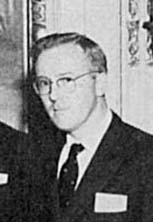Lionel Dickinson
From The Space Library
 Lionel Dickinson circa 1960 | |
| Birth Name | Lionel A. Dickinson |
|---|---|
| Birth Place | UK |
| Occupation | Scientist, Chemisy |
| Nationality | UK - Canada - United States of America |
Born in the United Kingdom, Lionel A. Dickinson worked at the Rocket Propulsion Establishment in Westcott England where he was a supervisor on propellant development. He emigrated to Canada in August 1955 with his wife and two children. By the late 1950s Dickinson was working for the Canadian Armament Research & Development Establishment (CARDE) in Valcartier Quebec where he devised a more powerful and readily usable solid fuel propellant for rockets. His title at CARDE was Group Leader, Rocket Engine and Propellant Development.
His new fuel was known as Cardeplex and combined a polyurethane fuel with a perchlorate oxidizer. Cardeplex could be cast into the rocket casing which diminished the probability of cracking and also created a smoother burn. The smooth burn meant that the casing could be thinner as it was less prone to excessive heating before burn-out.
The first test firing of Cardeplex in a rocket took place on February 24th 1959 at the CARDE facility in Valcartier Quebec. The Propulsion Test Vehicle engine would output 20,000 pounds of thrust for 20 seconds, which was about 25% better than the British Skylark rocket from which it had been derived. This Canadian rocket would be called Black Brant and would be launched for the first time seven months later, on September 5th 1959, at the USAF-operated Churchill Rocket Range facility in Manitoba Canada. A month later Dickinson became a member of the Canadian Aeronautical Institute.
Dickinson would continue to work for CARDE until being offered work at the Stanford Research Institute in California. He then spent the rest of his career working for the Explosive Ordnance Department of the U.S. Navy in Maryland.
